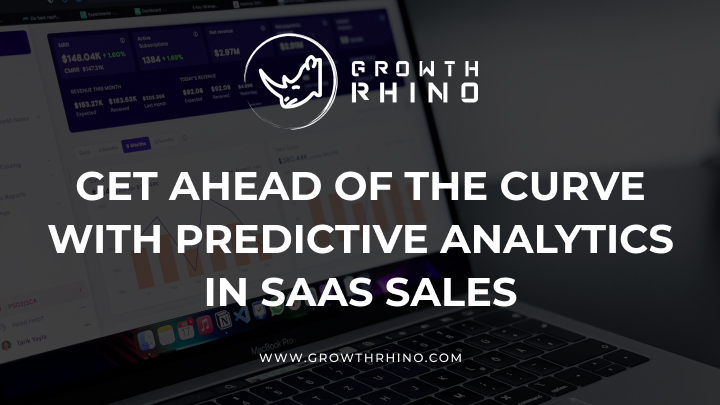
Predictive analytics is a powerful tool for businesses, particularly in the realm of software-as-a-service (SaaS) sales. By using predictive analytics, companies can anticipate and plan for future outcomes, making informed decisions that can give them a competitive edge.
This blog post will explore how predictive analytics can be used in SaaS sales and how it can help businesses get ahead of the curve.
What is Predictive Analytics?
Predictive analytics is a type of data analysis that uses statistical models and machine learning techniques to identify patterns in data and make predictions about future outcomes. It can forecast trends, identify potential risks, and optimize business operations.
Predictive analytics can be applied to various business functions, including sales, marketing, finance, and supply chain management. In the context of SaaS sales, predictive analytics can identify customer behavior patterns, forecast demand for products and services, and optimize sales processes.
Why Use Predictive Analytics in SaaS Sales?
There are several benefits to using predictive analytics in SaaS sales. Here are a few key reasons why it can be a valuable tool for businesses:
Improved Forecasting Accuracy
One of the primary benefits of predictive analytics is that it can help businesses improve their forecasting accuracy. By analyzing historical data and identifying patterns, companies can make more accurate predictions about future demand for their products and services.
This can help them better plan for the future and make informed resource allocation and budgeting decisions. So, rather than relying on guesswork, businesses can use predictive analytics to make sure their sales efforts are accurately targeting the right customers.

Enhanced Customer Insights
Predictive analytics can also help businesses gain deeper insights into customers' needs, preferences, and behaviors. Companies can identify patterns and trends that inform marketing and sales strategies by analyzing customer data.
This can help them target their efforts more effectively and tailor their products and services to meet customer needs better. Also, predictive analytics can help organizations identify at-risk customers and take steps to prevent churn.
Increased Efficiency
Predictive analytics can also help businesses optimize their sales processes and improve efficiency. Businesses can streamline their operations and reduce costs by identifying bottlenecks and inefficiencies in the sales process.
This can help them maximize their resources and increase profitability. So, predictive analytics can help businesses optimize their sales efforts and ensure they're getting the most out of their resources.
Competitive Advantage
Finally, using predictive analytics can give businesses a competitive edge by helping them anticipate and plan for future outcomes. By staying ahead of the curve and making informed decisions, businesses can stay one step forward of their competitors and position themselves for long-term success.
This helps them stay competitive and maximize their market share. So, predictive analytics can be a valuable tool for businesses that want to get ahead of the curve and remain competitive in an ever-changing SaaS landscape.
How to Implement Predictive Analytics in SaaS Sales?
If you're interested in using predictive analytics in your SaaS sales efforts, here are a few steps you can take to get started:
Define Your Goals
Before you start implementing predictive analytics, it's crucial to have a clear understanding of what you hope to achieve. Do you want to improve your forecasting accuracy? Do you want to gain deeper insights into your customers' needs and behaviors? Or do you want to optimize your sales processes?
By defining your goals upfront, you can tailor your predictive analytics efforts to address specific business challenges and opportunities. This way, you can ensure you get the most out of your efforts.
Collect and Clean Your Data
Predictive analytics relies on data, so the first step in implementing it is to collect and clean your data. This includes gathering data from various sources, such as customer records, sales data, and marketing data.
It's vital to ensure that your data is accurate, complete, and up-to-date, as this will be the foundation for your predictive analytics efforts. Because if not, any predictions or insights you generate could be misleading or inaccurate.

Choose the Right Tools
Many different tools and technologies are available for predictive analytics, ranging from simple spreadsheet programs to advanced machine-learning platforms. When choosing the right tools for your business, it's essential to consider your budget and resources, as well as your organization's specific goals and needs.
Some popular tools for predictive analytics include Python, R, and SAS. And some other platforms online are IBM Watson, Microsoft Azure ML Studio, and Tableau. By leveraging the right tools for your organization, you can ensure you're getting the most out of your predictive analytics efforts.
Build Your Models
Once you have your data and tools in place, the next step is to build your predictive models. This involves choosing the appropriate statistical methods and machine learning algorithms to analyze your data and then training and testing your models to ensure they are accurate and reliable.
It's essential to have a team of data scientists or analysts experienced in predictive analytics to help with this process. People may find it hard to understand the complex mathematical and statistical models used in predictive analytics.
Implement and Monitor Your Predictive Analytics Strategy
Once you have built and tested your predictive models, it's time to implement them in your SaaS sales efforts. This may involve integrating them into your CRM system or using them to inform sales and marketing strategies.
It's also essential to monitor the performance of your predictive analytics strategy's performance and make adjustments based on the results you see. This way, you can ensure that you're getting maximum value from your predictive analytics efforts.
Conclusion
Predictive analytics can be a powerful tool for SaaS businesses, helping them forecast trends, gain insights into customer behavior, and optimize sales processes. By implementing predictive analytics and staying ahead of the competition, businesses can gain a competitive edge and position themselves for long-term success.
So don't let the time-consuming process and complex technical tools scare you away — with the correct data, tools, and experts, you can make predictive analytics work for your SaaS business. If you want to get ahead of the curve and position yourself for success, now's the time to start! Good luck on your predictive analytics journey!
